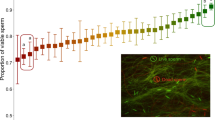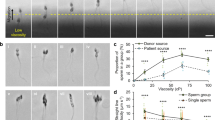Abstract
MOST male animals produce a large number of spermatozoa, whereas their females produce a relatively small number of eggs. Classically, this has been related to dilution problems in the external fertilizing medium of the female genital tract, and to synergic effects of super-numerary sperm in dissolving egg membranes or stimulating the female tract. The wide range of sperm redundancy (from 2.0 to 2 × 1010), however, suggested that another more immediate cause may be responsible. If a multiple process during spermiogenesis regularly fails in a proportion of attempts, then the number of “perfect” sperm may only be a small proportion of the total, the total produced being related logarithmically to the number of such faulty multiple processes in the production of each sperm. For example, if half such processes are faulty, then it is to be expected that  where P is the number of processes in the production of one sperm, r is the sperm redundancy, R is the sperm number divided by the zygote number for one copulation, and n is the (small) number of “perfect” sperm still required for each egg to meet the exigencies of random collision paths. It was found (Fig. 1) that for those few organisms for which both chiasma frequency and sperm redundancy have been investigated, a logarithmic correlation of the form
where P is the number of processes in the production of one sperm, r is the sperm redundancy, R is the sperm number divided by the zygote number for one copulation, and n is the (small) number of “perfect” sperm still required for each egg to meet the exigencies of random collision paths. It was found (Fig. 1) that for those few organisms for which both chiasma frequency and sperm redundancy have been investigated, a logarithmic correlation of the form  fits the points well. This may be taken to imply that about one in three chiasmata has a result which renders the resultant sperm less than “perfect”.
fits the points well. This may be taken to imply that about one in three chiasmata has a result which renders the resultant sperm less than “perfect”.
This is a preview of subscription content, access via your institution
Access options
Subscribe to this journal
Receive 51 print issues and online access
$199.00 per year
only $3.90 per issue
Buy this article
- Purchase on Springer Link
- Instant access to full article PDF
Prices may be subject to local taxes which are calculated during checkout
Similar content being viewed by others
References
Lewis, K. R., and John, B., Chromosoma, 18, 287 (1965).
Whitehouse, H. L. K., Towards an Understanding of the Mechanism of Heredity (Arnold, London, 1965).
Author information
Authors and Affiliations
Rights and permissions
About this article
Cite this article
COHEN, J. Correlation between Sperm “Redundancy” and Chiasma Frequency. Nature 215, 862–863 (1967). https://doi.org/10.1038/215862a0
Received:
Issue Date:
DOI: https://doi.org/10.1038/215862a0
This article is cited by
-
Social dominance explains within-ejaculate variation in sperm design in a passerine bird
BMC Evolutionary Biology (2017)
-
No evidence that sperm morphology predicts paternity success in wild house wrens
Behavioral Ecology and Sociobiology (2013)
-
Sperm length variation in House Wrens Troglodytes aedon
Journal of Ornithology (2013)
-
Subzonal sperm insertion and the frequency of gamete fusion
Journal of Assisted Reproduction and Genetics (1992)
-
Explanation of sterility in txty male mice
Nature (1980)
Comments
By submitting a comment you agree to abide by our Terms and Community Guidelines. If you find something abusive or that does not comply with our terms or guidelines please flag it as inappropriate.



